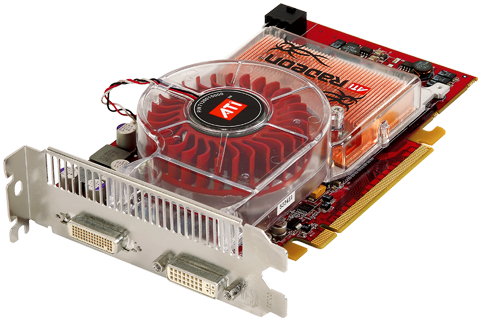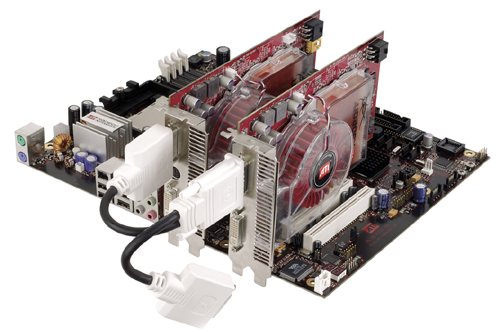ATI's Multi-GPU Solution: CrossFire
by Anand Lal Shimpi & Derek Wilson on May 30, 2005 9:00 PM EST- Posted in
- GPUs
ATI's Answer to SLI: CrossFire (The Card)
ATI does not have dedicated silicon on their GPUs for chip-to-chip communications as NVIDIA does. ATI bills this as a positive aspect of their solution, as their CrossFire solution is capable of running cards with two different (and even different speed) GPUs. NVIDIA's SLI solution is restricted to running on not only the same model of card, but cards with the same video BIOS. Timing is crucial when hooking the two GPUs together for SLI. In fact, an out-of-spec SLI bridge can even cause problems. We will only be able to see which solution performs better when we get hardware in our hands, but if all things are equal, ATI will have the advantage here.
In order to make up for their lack of a chip-to-chip interconnect, ATI includes a Compositing Engine chip on their CrossFire card. Because of this, the CrossFire card can be paired with any Radeon X800 or X850 (there will be a CrossFire card for each flavor). The driver controls clock speeds of each card automatically and manages synchronization as necessary. Synchronizing boards can be done on a general scale and doesn't need to be clock for clock. All CrossFire cards have 16 pixel pipelines, but disable 4 pipelines when running in tandem with a 12 pipe Radeon. This is what allows ATI to provide a limited number of CrossFire cards to work with multiple Radeons. Each card does need its own x16 PCI Express slot, and the boards communicate through an external cable.

This may look more like the older 3dfx SLI solution, but in reality, the Radeon X800 or X850 sends its data digitally from the DVI output to the input on the CrossFire card, which then handles the data and forwards the final frame to the display device. Under alternate frame rendering (AFR), the data is simply sent on unchanged, but the Compositing Engine handles the combination of a split or supertiled frame, as well as the final rendering of ATI's super AA modes (more on these later).

In order to function properly, the standard and CrossFire cards share some system RAM. This allows each card access to all necessary data that doesn't need to be unique for each frame. ATI's driver handles splitting the workload and configuring a unique command queue for each card based on the application and the rendering mode selected. Rendering modes are not user selectable, and are predetermined through Catalyst AI. Each card also has access to its own system memory as usual.










57 Comments
View All Comments
Panndor - Monday, June 13, 2005 - link
Lets hope that this endevor by ATI doesn't end up in the same situation at the RAGE Fury Maxx they came up with. The last time they tried this they screwed it up and then cut support for the card like it never existed.Looks promising, but I could see problems if they allow different hardware to run in a combined mode as well.
Competition is good so maybe this will bring down the price of the boards and the cards now.
vision33r - Wednesday, June 1, 2005 - link
Those 2 X850XT PE cards add up to $1000+ alone while price of 6800U are going down.I think the biggest prob is not if this works or not, is if the mainboard performance is sacrificed due to the ATI north-bridge. I don't gave 90% of the time on my system, I can't sacrifice losing system performance for gaming perf.
xsilver - Wednesday, June 1, 2005 - link
what's funny is that a few months after the xfire is released, nvidia will probably announce SLI v2.0 and then everyone will talk about how that's so coolWesley Fink - Wednesday, June 1, 2005 - link
#49 & #50 - The Uli 1573 we've seen paired with Crossfire DOES suport NCQ. this was confirmed this afternoon with engineers here at Computex. The upcoming ULI 1575 southtridge supports both Sata 2 and NCQ.We also saw demos of Splinter Cell on Crossfire with the 2.0 Shader. The demos were at 1280x1024 with all eye candy enabled. Frame rates in the various demos were 118 to 120. Since we did not have reference benches for Splinter Cell, it didn't make much sense to publish these results in the launch article. What we have seen is very promising, but we need more "hands-on" benchmarking before we can say much more.
Wesley Fink
mkruer - Wednesday, June 1, 2005 - link
#51 That is the real question to be answered. My guess is that ATI will work on a SLI board and visa versa unless there is something specifically in hard coded that prevents the second slot from being used by anything other the chipsets manufactures video card, which is highly unlikely. From the BIOS and driver standpoint the MB is either has 1x16 PCIex slot or 2x8 PCIex slots.elecrzy - Tuesday, May 31, 2005 - link
its possible to have Crossfire work on the NF4/945/955. Its just that ATI won't support them through the drivers. Sigh...kmmatney - Tuesday, May 31, 2005 - link
Does the ULi southbridge have NCQ support?weblizard - Tuesday, May 31, 2005 - link
No Sata II or NCQ support. That's all I need to know to NOT want a crossfire system.bob661 - Tuesday, May 31, 2005 - link
#47I had the Abit board with the AMD chipset on it. Worked flawlessly. I gave it to a friend when I upgraded that box and it was running until last year when he upgraded his box.
sprockkets - Tuesday, May 31, 2005 - link
26# That was the 760MPX or the dual processor chipset. Don't recall any irongate issues (that was 750, 760 was the DDR version, right?)